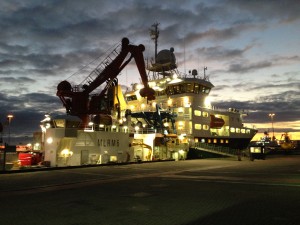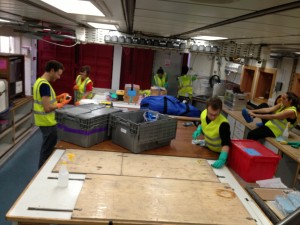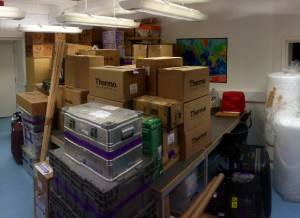Cruise Blog
10th October 2013: RRS James Cook
On Thursday and Friday of last week, a group of the scientists who will take part in the expedition travelled down to Southampton to load the ship (see previous blog for details). For myself and several others it was the first time that we had laid eyes on the RRS James Cook. She is an impressive sight, 89.5 m long and standing as tall as the back of the National Oceanography Centre (NOC) where she was moored. As big as she sounds, she needs to have a lot aboard. Each of us will have a snug cabin, fitted with a bed, desk and cupboards. There is also a spacious and very comfortable looking lounge area, complete with TV and Play Station 3 (cause for excitement for some of the guys) and a large mess where we will eat. As well as the living quarters, the Cook contains several permanent labs. These labs will be where most of the science is done; sorting and preservation of biological samples in the cold lab, water sample preservation and analysis in the chemistry lab, seafloor mapping in the main lab and sorting, drying and cutting of coral skeletons in the deck lab. Muddy sediment cores will be split and cut in the hanger towards the stern so we don’t trail mud all around the ship! All of the equipment for these tasks had to be securely tied, nailed or screwed in place to stop it flying everywhere once the Cook hits the open sea. After cleaning the labs to remove contamination from carbon 14 (the isotope we use for carbon dating), securing the equipment took most of our time, involving some inventive us of cable ties, bungees, rope and wooden slats to hold down everything from specialist scientific gear to a vacuum cleaner. Everything is now ready for us to climb aboard in Tenerife where we will see our ROV for the first time, and from where we will learn what it is like to live aboard a research ship.
Peter Spooner.
Find out more!
Glossary
Isotope – Isotopes of a chemical element all have the same number of protons in their nucleus, but have different numbers of neutrons.
Mess – Ship’s dining room.
ROV – Remotely Operated Vehicle. A robot that is controlled from the ship and is used for collecting samples and taking pictures of the deep ocean.
RRS – Royal Research Ship.
Stern – The rear part of a ship.
Links
RRS James Cook http://www.nerc.ac.uk/research/sites/facilities/marine/jamescook.asp
National Oceanography Centre http://noc.ac.uk/
What are isotopes?http://www.bbc.co.uk/schools/gcsebitesize/science/add_aqa_pre_2011/radiation/atomsisotopesrev2.shtml

Photo by: Paul Morris

Photo by: Paul Morris
30th September 2013: Packing
This week, a good chunk of the research scientists going on the TROPICS cruise will be heading somewhere a little less tropical to start loading the ship: Southampton. We’ll have to make sure everything is on board that we need, from science kit (bottles, equipment, chemicals…), to personal items (books, shower gel, coffee…). It’s a long cruise, and we won’t be able to stock up on anything that gets accidentally left behind! 130 boxes are on there way, so lets hope it is everything! We’ll also clean and organise the labs, so they’re all set up and ready for action when we see the ship again in warmer climes. The research vessel, the RRS James Cook, will sail from Southampton to Tenerife, where we will meet it again on October 11th.

As a press officer for the European Research Council, I would be happy to follow the cruise from the inside.
Thanks a lot,
Best, Maud